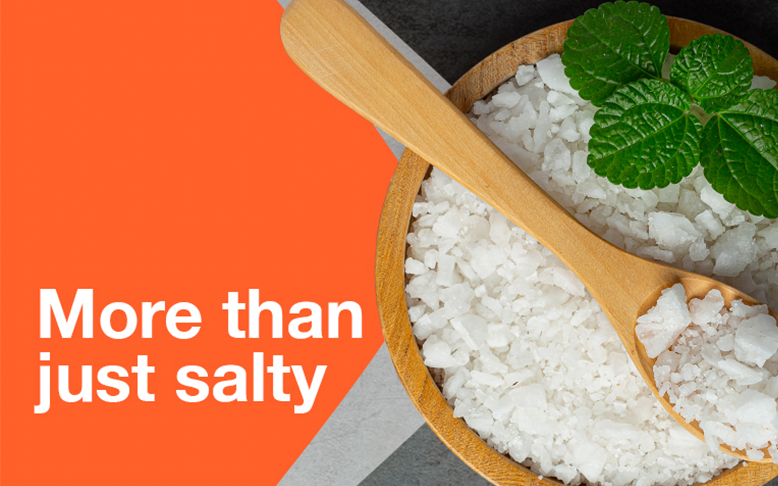Introduction
In preparing healthy and appealing meals for the family, customers, and patients, taste is the most important aspect to consider. Seasoning food may be achieved by adding salt, pepper, sugar, herbs, spices, and flavor enhancers. The goal of seasoning is to draw out the food's natural flavor without altering it.
Monosodium glutamate or MSG is a common flavor enhancer used in homes and commercial kitchens. Evidence-based research continues to explore the usefulness and safety of MSG. Let us have a deeper understanding of this widely used ingredient and its potential health effects.
What is MSG?
Monosodium glutamate (MSG), also called monosodium L-glutamate or sodium glutamate, is a sodium salt of the non-essential amino acid glutamic acid.1,2 The substance can be naturally found in many food sources, such as tomatoes, and cheeses,1,3 in the form of glutamic acid.4 It was first discovered by a Japanese chemist by extracting it from a seaweed broth.1 The white crystalline powder is now produced commercially through the fermentation process of starch, sugar beets, sugar cane, or molasses.3
MSG has been used for many years as an added ingredient to enhance the natural flavor of a variety of foods. In particular, it has been an important ingredient in Asian cuisines and is added in broths, soups, canned and frozen vegetables, flavoring and spice blends, meat, and gravies.1
Why Do People Use MSG?
MSG is a widely used ingredient and food additive for various reasons. MSG is a flavor enhancer, making dishes more savory and palatable. In Asian cooking, MSG is often used to improve umami flavor and aroma.5 It is also regularly incorporated into fermented Asian condiments, such as soy sauce and fermented bean paste, to balance the flavors.6 MSG can mask the unpleasant bitter, pungent taste that results from natural fermentation. Additionally, MSG is added to processed foods like canned soups and meat products as well as to frozen convenience products to help preserve the taste of these foods.6 Moreover, MSG is used to substitute some salt in reduced-sodium foods while maintaining their palatability.5 Lastly, MSG is commonly used for its practicality and cost-effectiveness. It can improve the flavor of fast-food and restaurant meals without the need for extensive preparation6 or large quantities.
How Does MSG Work as a Flavor Enhancer?
MSG provides a distinct taste known as umami, described as an earthy, meaty, or savory taste.7 Umami is one of the five basic tastes along with sweet, sour, salty, and bitter.8 Umami indicates the presence of proteins and nucleotides in food.8 Apart from MSG, other recognized umami substances include inosine 5’-monophosphate (IMP) and guanosine 5’-monophosphate (GMP).8,9
Umami substances stimulate specific taste receptors of the taste buds.8 Signals from these receptors are transmitted to the central nervous system via taste nerves, activating areas in the brain responsible for taste identification and different sensations, such as pleasure, satisfaction, and contentment.8 Hence, when taste receptors are stimulated by the umami substance MSG, the information is transmitted to the brain, leading to the perception of umami.10
The detection of umami stimulates the production of saliva and digestive fluids.10 Umami taste triggers salivary secretion for a longer period of time than a sour or acid taste.8,10 Moreover, the saliva generated in response to sour taste possesses a lighter consistency, while the saliva induced by umami is more viscous, contributing to increased moisture within the oral cavity.10
By promoting salivation, umami taste may enhance the functions of saliva. Saliva is important in taste perception by aiding in the dissolution of food particles, facilitating the detection of taste substances. It begins the process of breaking down food, releasing taste substances that interact with the taste receptors. Additionally, saliva plays a crucial role in supporting the proper function of taste cells as it protects them from stress and pathological infections.8
What are the Benefits of Using MSG?
MSG provides several benefits.
- Flavor enhancement
Since the early 1900s, MSG has been used as a flavor enhancer. MSG is known for its ability to enhance the umami taste in foods. With the use of MSG, the meatiness, savory aroma, and flavor of some processed meats, soups, stews, and other foods are intensified.7 Also, studies have shown that incorporating MSG into certain foods enhances their palatability. These improvements in taste may be due in part to changes in the sensory properties of the foods, including heightened richness, savoriness, and improved mouthfeel qualities.4
- Reduced sodium content
Choosing MSG over table salt (sodium chloride or NaCl) may reduce salt intake, Replacing some of the table salt (sodium chloride or NaCL) with MSG may reduce sodium intake, lowering the risk of sodium-related chronic diseases like hypertension and cardiovascular issues.11 MSG has about 12% sodium (42 milligrams per teaspoon), whereas one teaspoon of table salt (sodium chloride) contains about 40% sodium (equivalent to 2300 milligrams per teaspoon).7 Studies have shown that MSG can help reduce the amount of salt content in food without sacrificing the taste.2,12 Moreover, partly replacing salt with MSG in foods can lead to a reduction in sodium intake of consumers.7,12 A study in the US showed that the addition of MSG in certain foods can result in about a 3% reduction in overall sodium intake in the population.12
Did you know? 1 tsp of salt = 2300 mg sodium 1 tsp of MSG = 42 mg sodium |
- Improved taste in aging people
Elderly individuals may face nutrition challenges when the meals are not appealing and lack flavor, leading to inadequate food intake. Age-related taste impairment is often attributed to reduced salivation.10 Some reports propose that using umami to stimulate salivation could potentially enhance the taste sense among older individuals.7,10 Using MSG will increase the flavor and palatability of foods for the elderly, which may result in improved nutritional status.
Is MSG Safe to Consume?
The United States Food and Drug Administration (FDA), the Food and Agriculture Organization (FAO) and the World Health Organization (WHO) Joint Expert Committee on Food Additives (FAO/WHO JECFA), and the European Food Safety Association (EFSA) acknowledged MSG as a safe ingredient for human consumption.9
The FDA classifies glutamate as a “Generally Recognized as Safe” (GRAS) ingredient,3 placing it in the same category as commonly used food ingredients like salt, vinegar, and baking powder.4
Based on their findings, the JECFA committee concluded that it was unnecessary to establish a numerical Acceptable Daily Intake (ADI), a measure often utilized as a reference for determining the maximum safe levels of consumption for food additives.4 The EFSA established an ADI of 30mg per kilogram of body weight per day in 2017.9
What are the Controversies Surrounding MSG?
Below are the purported negative effects of MSG consumption on human health, making the use of this additive a controversial issue.
- MSG causes headaches and migraines. Glutamate, found in MSG, has been reported to trigger migraine headaches.4 Reports of headache and nausea after eating foods containing MSG have been received by the US FDA.3
- MSG causes Chinese restaurant syndrome. MSG has been alleged to trigger various adverse reactions in individuals who have consumed foods containing this additive. MSG has been implicated as the cause of a complex of symptoms, commonly known as Chinese restaurant syndrome (CRS) due to their occurrence following consumption of a Chinese meal.14 More recently, the syndrome was called “MSG symptom complex” (MSC). There are a number of MSC symptoms, but the most frequently reported ones are headache, numbness/tingling, flushing, muscle tightness, and generalized weakness.14
- MSG causes obesity. A study in China presented anthropological data indicating a potential connection between glutamate intake and an increased risk of being overweight, irrespective of physical activity levels and total energy intake.4
It was not confirmed that the reported adverse symptoms were caused by MSG, according to the FDA.3 Clinical data is lacking to prove that glutamate could trigger migraine or any type of headache.4 An independent group, the Federation of American Societies for Experimental Biology (FASEB), identified generally mild, transient symptoms like headache, numbness, flushing, tingling, palpitations, and drowsiness, which may be experienced by sensitive individuals when they ingest 3 grams or more of MSG without food.3 However, a typical serving of food containing added MSG has less than 0.5 grams, making it unlikely to consume more than 3 grams of MSG at once without food.3 The FASEB review concluded that MSG poses no health hazard to the general population.
While the health authorities recognize the safety of MSG, numerous animal studies reveal potential adverse effects from chronic MSG consumption particularly at high doses.13 These effects have been observed in various organs, including the thymus, brain, pancreas, testis, liver, and kidney, and have been associated with several health issues, including obesity, hypertension, headaches, asthma exacerbation, neurotoxic effects, and harmful impacts on reproductive organs.13 However, the accuracy of these previous preclinical and clinical animal studies and their relevance for chronic dietary human exposure have been questioned for various reasons.2,9 These include methodological flaws, a lack of adequate control groups, small sample sizes, low dosage accuracy, use of extremely high doses, and different routes of administration.9
Given the benefits of using MSG in preparation and cooking, and the recognition of this food additive by experts and health authorities as safe for human consumption, one question remains: “Are the registered nutritionists-dietitians open to utilizing MSG as an ingredient to enhance the flavor of the food?”
What are other Options for Improving the Flavor of Foods?
Several umami-rich ingredients, such as meat, seafood, and vegetables, can be used to enhance the flavor of food.10
The table below provides a list of common umami-rich foods as a reference for including umami-rich ingredients in the preparation and cooking process.
Table 1. Umami-rich ingredients and their glutamate content per 100g (Umami Information Center, n.d.)
Group | Ingredients | Glutamate (mg/100g) |
Seaweeds | Rausu kombu | 2290~3380 |
nori | 170~1350 | |
Tea | green tea | 17~670 |
Vegetables, Beans, Potatoes | tomatoes | 150~250 |
dried tomatoes | 650~ 1140 | |
green peas | 110 | |
garlic | 100 | |
corn | 70-110 | |
soybean | 30-70 | |
Chinese cabbage | 20-90 | |
potatoes | 30-100 | |
sweet potatoes | 60 | |
spinach | 50-70 | |
carrots | 20-80 | |
bamboo shoots | 14-90 | |
asparagus | 30-50 | |
daikon radish | 30-70 | |
cabbage | 30-50 | |
onion | 20-50 | |
green onion | 20-50 | |
broccoli | 30-60 | |
celery | 20-30 | |
ginger | 20 | |
Mushroom | dried shitake mushroom | 1060 |
shitake mushroom | 70 | |
enoki mushroom | 90 | |
common mushroom | 40-110 | |
Seafoods | scallop | 140 |
shrimp /prawn | 120 | |
squid | 20-30 | |
octopus | 20-30 | |
sardine | 10-20 | |
tuna | 1-10 | |
mackerel | 10-30 | |
clam | 210 | |
mussel | 110 | |
anchovies | 630 | |
salted squid | 620 | |
Egg and Meats | chicken eggs | 20 |
pork | 10 | |
chicken | 20-50 | |
beef | 10 | |
dried cured meats | 340 | |
Dairy Products | Parmigiano cheese | 1200-1680 |
Emmental cheese | 310 | |
Cheddar cheese | 180 | |
Fermented Products | nampla ( fish sauce) | 950 |
oyster sauce | 900 | |
soy sauce | 400-1700 | |
miso | 200-700 | |
kimchi | 240 |
Practical Food Preparation Tips Using Umami Ingredients
- Incorporate natural umami ingredients into your recipes such as tomatoes, garlic, mushrooms, soybeans, soy sauce, and anchovies.
- To boost the flavor of pasta, pizza, and salad recipes, add or top with anchovies.
- Use some amount of soy sauce as marinades before searing the meat and use it as a dipping sauce.
- Grate Parmesan cheese over pasta and casserole dishes.
- Add dried mushrooms when making flavorful broth or stock.
- Utilize tomato sauce or tomato paste in stewing and braising meats.
- Explore and apply suggested umami food pairing:
- Western cuisine: pasta and pizza (cheese and tomato sauce)
- Asian cuisine: soup, ramen stir-fried noodles (broth, meat, and tofu)
- European cuisine: stews, pasta, and sandwiches (tomato sauce and mushroom)
- Regional Filipino food: fritters, vegetable spring rolls (vegetable and shrimp fritters)
Message to RNDs:
With the love and hate relationship in using MSG, just remember the letters M.S.G. to make sure that the food being prepared is flavorful yet nutritious.
- Moderately use MSG for seasoning. It is recommended to quantify the amount of seasoning by standardizing the recipe and indicating the exact amount incorporated per recipe. Utilization of natural ingredients rich in umami is highly recommended.
- Season and taste the food during the cooking process to enhance the quality of food to make it palatable and satisfying.
- Good Nutrition, Wellness, and Safety must be considered when preparing quality food.


 Geraldine Maglalang Cabello , RND
Geraldine Maglalang Cabello , RND














No comments here yet.